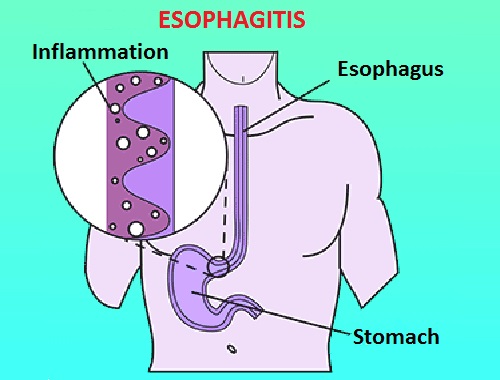Eosinophilic Esophagitis

Published: 18 Jun 2025
ICD9: 530.13 ICD10: K20.0 ICD11: DA24.1
Eosinophilic Esophagitis (EoE) is a chronic, immune-mediated inflammatory disease of the esophagus.
Let's break that down:
![]() Chronic: This means it's a long-term condition.
Chronic: This means it's a long-term condition.
![]() Immune-mediated: The body's immune system is involved in causing the inflammation.
Immune-mediated: The body's immune system is involved in causing the inflammation.
![]() Inflammatory: There's swelling and irritation of the esophageal tissue.
Inflammatory: There's swelling and irritation of the esophageal tissue.
![]() Esophagus: The tube that carries food from your mouth to your stomach.
Esophagus: The tube that carries food from your mouth to your stomach.
Key Characteristics:
![]() High number of eosinophils in the esophagus: Eosinophils are a type of white blood cell that normally help fight off parasites. In EoE, they accumulate in the esophageal lining.
High number of eosinophils in the esophagus: Eosinophils are a type of white blood cell that normally help fight off parasites. In EoE, they accumulate in the esophageal lining.
![]() Esophageal dysfunction: This leads to symptoms like difficulty swallowing (dysphagia), food impaction (food getting stuck), and chest pain.
Esophageal dysfunction: This leads to symptoms like difficulty swallowing (dysphagia), food impaction (food getting stuck), and chest pain.
![]() Often triggered by food allergens: While not a true allergy in the traditional sense, EoE is frequently linked to sensitivities to certain foods.
Often triggered by food allergens: While not a true allergy in the traditional sense, EoE is frequently linked to sensitivities to certain foods.
In simpler terms:
EoE is like an allergic reaction in the esophagus. The body mistakenly attacks the esophageal lining, causing inflammation and making it difficult to swallow.
Symptoms:
Symptoms vary depending on age:
![]() Infants and young children:
Infants and young children:![]()

![]() Feeding difficulties
Feeding difficulties![]()

![]() Vomiting
Vomiting![]()

![]() Failure to thrive
Failure to thrive![]()

![]() Abdominal pain
Abdominal pain
![]() Older children and adults:
Older children and adults:![]()

![]() Dysphagia (difficulty swallowing)
Dysphagia (difficulty swallowing)![]()

![]() Food impaction (food getting stuck in the esophagus)
Food impaction (food getting stuck in the esophagus)![]()

![]() Chest pain
Chest pain![]()

![]() Heartburn that doesn't respond to typical heartburn medications
Heartburn that doesn't respond to typical heartburn medications![]()

![]() Abdominal pain
Abdominal pain![]()

![]() Regurgitation
Regurgitation
Causes:
The exact cause of EoE isn't fully understood, but it's believed to be a combination of:
![]() Genetic predisposition: Some people are more likely to develop EoE than others.
Genetic predisposition: Some people are more likely to develop EoE than others.
![]() Environmental factors: Food allergens are a major trigger. Other possible triggers include airborne allergens like pollen, mold, dust mites, and animal dander.
Environmental factors: Food allergens are a major trigger. Other possible triggers include airborne allergens like pollen, mold, dust mites, and animal dander.
![]() Immune system dysregulation: The immune system overreacts to certain stimuli, leading to inflammation in the esophagus.
Immune system dysregulation: The immune system overreacts to certain stimuli, leading to inflammation in the esophagus.
Diagnosis:
![]() Endoscopy: A thin, flexible tube with a camera is inserted into the esophagus to visualize the lining.
Endoscopy: A thin, flexible tube with a camera is inserted into the esophagus to visualize the lining.
![]() Biopsy: Small tissue samples are taken during the endoscopy and examined under a microscope to count the number of eosinophils. A diagnosis of EoE is made if there are 15 or more eosinophils per high-power field (HPF).
Biopsy: Small tissue samples are taken during the endoscopy and examined under a microscope to count the number of eosinophils. A diagnosis of EoE is made if there are 15 or more eosinophils per high-power field (HPF).
Treatment:
The goals of treatment are to reduce inflammation in the esophagus and relieve symptoms. Treatment options include:
![]() Dietary therapy:
Dietary therapy:![]()

![]() Elimination diets: Removing common allergenic foods (like milk, soy, wheat, eggs, nuts, and seafood) from the diet.
Elimination diets: Removing common allergenic foods (like milk, soy, wheat, eggs, nuts, and seafood) from the diet.![]()

![]() Elemental diet: Consuming a formula that contains amino acids instead of whole proteins.
Elemental diet: Consuming a formula that contains amino acids instead of whole proteins.
![]() Medications:
Medications:![]()

![]() Topical corticosteroids: Swallowed steroids that coat the esophagus and reduce inflammation.
Topical corticosteroids: Swallowed steroids that coat the esophagus and reduce inflammation.![]()

![]() Proton pump inhibitors (PPIs): Medications that reduce stomach acid production (sometimes used even though EoE isn't directly related to acid reflux).
Proton pump inhibitors (PPIs): Medications that reduce stomach acid production (sometimes used even though EoE isn't directly related to acid reflux).![]()

![]() Dupilumab (Dupixent): A biologic medication that targets specific proteins involved in the inflammatory process.
Dupilumab (Dupixent): A biologic medication that targets specific proteins involved in the inflammatory process.
![]() Esophageal dilation: A procedure to stretch the esophagus if it has become narrowed due to inflammation.
Esophageal dilation: A procedure to stretch the esophagus if it has become narrowed due to inflammation.
In summary, Eosinophilic Esophagitis is a chronic inflammatory condition of the esophagus characterized by a high number of eosinophils, often triggered by food allergens, and causing symptoms like difficulty swallowing and food impaction. Diagnosis involves endoscopy and biopsy, and treatment aims to reduce inflammation and relieve symptoms through dietary changes and medications.
It's important to see a gastroenterologist or allergist if you suspect you have EoE. They can properly diagnose the condition and recommend the most appropriate treatment plan.